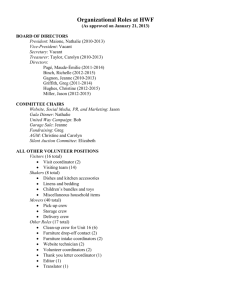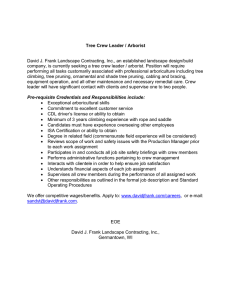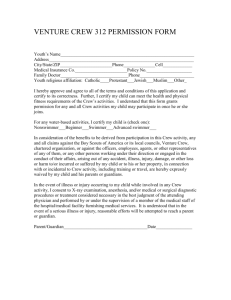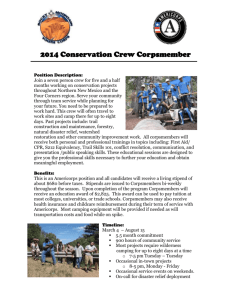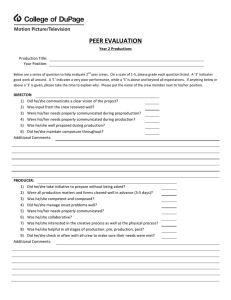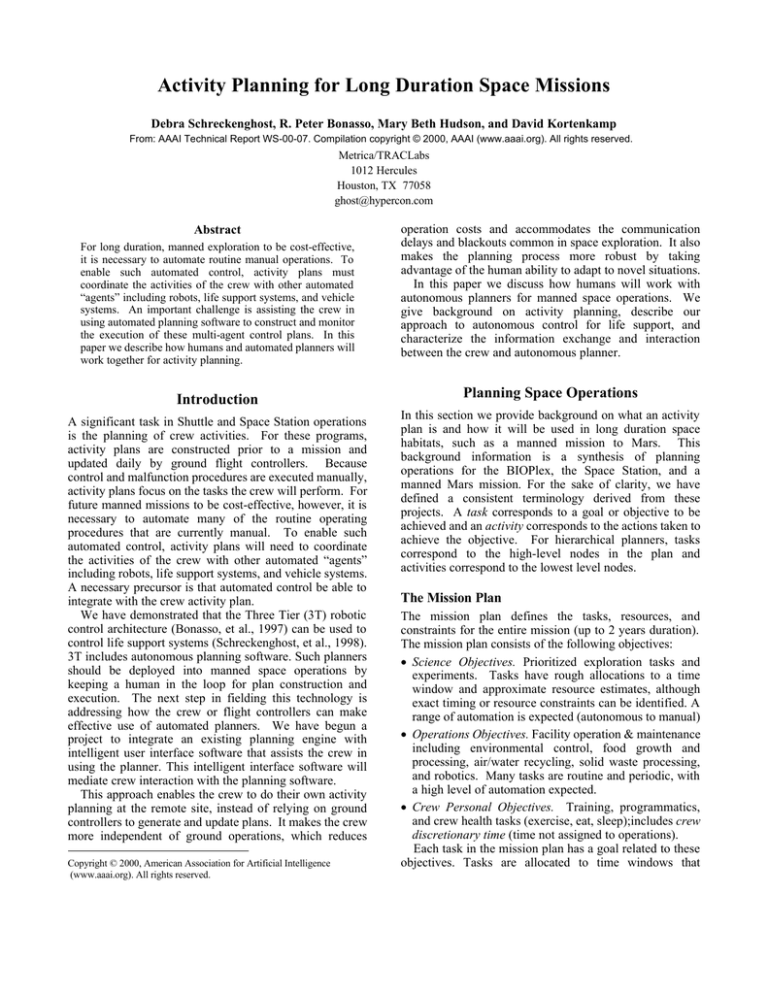
Activity Planning for Long Duration Space Missions
Debra Schreckenghost, R. Peter Bonasso, Mary Beth Hudson, and David Kortenkamp
From: AAAI Technical Report WS-00-07. Compilation copyright © 2000, AAAI (www.aaai.org). All rights reserved.
Metrica/TRACLabs
1012 Hercules
Houston, TX 77058
ghost@hypercon.com
Abstract
For long duration, manned exploration to be cost-effective,
it is necessary to automate routine manual operations. To
enable such automated control, activity plans must
coordinate the activities of the crew with other automated
“agents” including robots, life support systems, and vehicle
systems. An important challenge is assisting the crew in
using automated planning software to construct and monitor
the execution of these multi-agent control plans. In this
paper we describe how humans and automated planners will
work together for activity planning.
Introduction
A significant task in Shuttle and Space Station operations
is the planning of crew activities. For these programs,
activity plans are constructed prior to a mission and
updated daily by ground flight controllers. Because
control and malfunction procedures are executed manually,
activity plans focus on the tasks the crew will perform. For
future manned missions to be cost-effective, however, it is
necessary to automate many of the routine operating
procedures that are currently manual. To enable such
automated control, activity plans will need to coordinate
the activities of the crew with other automated “agents”
including robots, life support systems, and vehicle systems.
A necessary precursor is that automated control be able to
integrate with the crew activity plan.
We have demonstrated that the Three Tier (3T) robotic
control architecture (Bonasso, et al., 1997) can be used to
control life support systems (Schreckenghost, et al., 1998).
3T includes autonomous planning software. Such planners
should be deployed into manned space operations by
keeping a human in the loop for plan construction and
execution. The next step in fielding this technology is
addressing how the crew or flight controllers can make
effective use of automated planners. We have begun a
project to integrate an existing planning engine with
intelligent user interface software that assists the crew in
using the planner. This intelligent interface software will
mediate crew interaction with the planning software.
This approach enables the crew to do their own activity
planning at the remote site, instead of relying on ground
controllers to generate and update plans. It makes the crew
more independent of ground operations, which reduces
Copyright © 2000, American Association for Artificial Intelligence
(www.aaai.org). All rights reserved.
operation costs and accommodates the communication
delays and blackouts common in space exploration. It also
makes the planning process more robust by taking
advantage of the human ability to adapt to novel situations.
In this paper we discuss how humans will work with
autonomous planners for manned space operations. We
give background on activity planning, describe our
approach to autonomous control for life support, and
characterize the information exchange and interaction
between the crew and autonomous planner.
Planning Space Operations
In this section we provide background on what an activity
plan is and how it will be used in long duration space
habitats, such as a manned mission to Mars. This
background information is a synthesis of planning
operations for the BIOPlex, the Space Station, and a
manned Mars mission. For the sake of clarity, we have
defined a consistent terminology derived from these
projects. A task corresponds to a goal or objective to be
achieved and an activity corresponds to the actions taken to
achieve the objective. For hierarchical planners, tasks
correspond to the high-level nodes in the plan and
activities correspond to the lowest level nodes.
The Mission Plan
The mission plan defines the tasks, resources, and
constraints for the entire mission (up to 2 years duration).
The mission plan consists of the following objectives:
• Science Objectives. Prioritized exploration tasks and
experiments. Tasks have rough allocations to a time
window and approximate resource estimates, although
exact timing or resource constraints can be identified. A
range of automation is expected (autonomous to manual)
• Operations Objectives. Facility operation & maintenance
including environmental control, food growth and
processing, air/water recycling, solid waste processing,
and robotics. Many tasks are routine and periodic, with
a high level of automation expected.
• Crew Personal Objectives. Training, programmatics,
and crew health tasks (exercise, eat, sleep);includes crew
discretionary time (time not assigned to operations).
Each task in the mission plan has a goal related to these
objectives. Tasks are allocated to time windows that
specify timing constraints such as earliest start time, latest
stop time, or frequency for periodic tasks. Plans include
resource estimates and task allocations to types of agents.
The mission plan can be evaluated by reviewing resource
estimates & agent workload for the plan. Resource models
used for this level of planning are coarse and conservative.
Significant human involvement, including Earth-based
operations, is expected in defining the mission. Mission
planning tasks are directly related to mission objectives
and usually will not include the detailed steps to
accomplish them. Instead, tasks represent producers or
consumers of resources over a time period. Constraints are
related to crew and mission safety and task priorities
arising from mission objectives.
The Activity Plan
The activity plan takes the abstracted tasks from the
mission plan and determines the actual activities and
resources needed to perform these tasks (decomposition of
high-level goals into an action hierarchy). The time period
of the activity plan can cover a week to a few months,
depending upon the mission (e.g., operations concepts for
human exploration of Mars define a 10-day activity plan).
The first step in building the activity plan is to determine
the goals and constraints that apply for the time period of
the plan. To do this, the crew reviews tasks from the
mission plan. Proposed experiments and exploration
activities are revisited. Some may be delayed beyond the
time period of the activity plan, which affects the mission
plan. Those retained may be re-prioritized. The loss of
system capabilities or significant differences between the
predicted and actual usage of consumables can result in
constraint changes affecting the activity plan, and possibly
the mission plan. The effectiveness and efficiency of
routine operations are reviewed with the goal of improving
system performance and crew satisfaction. Public relations
commitments are defined.
When the final set of goals have been determined and
the changes to constraints and resources made, the
planning software identifies the activities that will achieve
these goals and allocates these activities to be performed
by specific agents during well-defined time periods. The
crew evaluates the resulting plan with respect to agent
workload and resource production and usage. Significant
changes in resources or constraints (e.g., subsystem loss)
or task delays outside the time period of the activity plan
may require modifying the mission plan.
The activity plan will be re-evaluated routinely to
determine that it is still valid (i.e., goals and constraints
used to generate the plan still hold), to update goals based
on operational changes from Earth, and to make selections
among plan alternatives. For example, the activity plan for
the Lunar/Mars Life Support Test Project (LMLSTP)
Phase II test was evaluated every Sunday to build a weekly
schedule. This routine evaluation produces the following:
• Changes to crew schedule
• Plan updates for automated control operations
(stand-alone experiment controllers; integrated life
support and facility control; robotic operations)
• Downlink of plan changes to Earth-based operations
The activity plan includes the operation of autonomous
systems (robots, life support systems) because the crew
must be cognizant of autonomous operations to ensure
mission objectives are met.
Control of Life Support Systems
Life support systems are the hardware and software used to
manage consumables required to sustain human life. For a
remote space habitat, life support systems are needed for
air revitalization, trace contaminant removal, plant growth,
food production, water recovery, thermal control, and solid
waste processing. We have developed 3T control software
for air revitalization, plant growth, and water recovery.
3T Control Architecture
We use the 3T control architecture for autonomous control
of life support systems. It consists of the following tiers of
parallel control processing:
• Planner: The planning tier performs deliberative control.
It plans activities to achieve control objectives. The
planning software used in 3T is the Adversarial Planner
(AP; Elsaesser and MacMillan, 1991). AP is a nonlinear hierarchical task net (HTN) planner. It represents
and assigns tasks to multiple agents. It monitors the
execution of a plan, detects plan execution failure, and
replans dynamically at failure. AP was developed for
military planning. It was selected for 3T because its
approach to plan monitoring with quick plan repair is
needed in space applications. The optional capability to
model an adversary’s plans is not used for space.
• Sequencer: The sequencing tier performs procedural
control. It selects and orders tasks using a hierarchical
task decomposition predicated on the current world state.
Thus, task selection is dynamic and reactive to changes
in control conditions. Sequencing software is the
Reactive Action Package System (RAPS; Firby, 1989).
• Skill Manager: The skill manager implements closed
loop control. The activation of a skill corresponds to
starting closed loop control to change the state of control
hardware. Events can also be activated to monitor for
specific feedback from control instrumentation. The
skill manager software is written in the C language.
The parallel tiers of control processing represent different
control abstractions and response times. In general, the
control task becomes more abstracted and the response
time becomes larger as control moves up the tiers.
The 3T architecture operates with a top-down flow of
control and a bottom-up flow of control feedback. Leaf
activities in the plan hierarchy are mapped to top-level
RAPs by unifying the purpose of the planned activity with
a succeed clause in a RAP. The planner installs the
selected RAP on the task agenda for execution. The toplevel RAP is further decomposed into a hierarchy of
control tasks. Leaf tasks (primitives) in the RAPs task
hierarchy activate skills in the skill manager. The skills
pass commands to the control hardware. Feedback from
control instrumentation is passed from monitoring events
in the skill manager to the sequencer. The sequencer uses
these events to determine if the task executed successfully.
Once the task terminates, RAPs memory is modified to
reflect the new state. The planner monitors RAPs memory
for state changes related to activity execution status.
Product Gas Transfer Application
We developed life support planning software as part of a
3T system managing plant growth (Schreckenghost, et al.,
1998). This system was developed for the LMLSTP Phase
III test. During this test, a four-member crew lived in an
enclosed chamber for 90 days to simulate many of the
conditions of a remote planetary habitat. A primary test
objective was to demonstrate air revitalization using plants.
We built a 3T application to control the gas concentrations
in the plant chamber to ensure healthy plants and to
transfer recycled O2 to the crew. We also managed O2
buffering for use in solid waste incineration.
There was a typical 4-day planning cycle for production
and consumption of O2 and CO2. For 2 days, CO2 from
the crew was converted by the plants to O2 and the O2 was
returned to the crew chamber. For 1 day, O2 was buffered
in a tank for solid waste incineration. For the remaining
day, we circulated incineration effluent over the plants to
remove the high concentrations of CO2.
There was also a16-20 day planning cycle corresponding
to the planting and harvesting of the wheat used for air
revitalization. Since the O2 production of wheat varies by
a factor of 2 over the lifetime of a plant (~90 days), the
wheat crops were planted in stages during the test. At any
time there was a mix of crops in the chamber planted at 4
different times, separated by about 20 days. Crop staging
damped fluctuation in O2 production to an average level
sufficient for 1 person. The planner managed the planting
and harvesting of crop stages, including scheduling an
airlock for plant germination and scheduling humans for
the manual task of planting and harvesting. The airlock
also was used to buffer incineration effluent that was
hazardous to young plants.
Humans Working with Autonomous Planners
Autonomous control of routine operations for life support
and robots is an important enabler for long duration
habitation at remote space sites. Such autonomy frees the
crew from mundane operations, giving them more time for
exploration and experimentation. It reduces the workload
of Earth-based flight controllers, which is a significant cost
reduction for multi-month missions. And it avoids the
impacts of long communication delays on real-time
control. Yet these operations must be conducted safely and
with a high rate of success in achieving mission objectives.
We have demonstrated that safe autonomous operations
can be achieved by control software that supports
adjustable autonomy (Dorais, et al., 1998). By adjustable
autonomy we mean that the humans and the autonomous
control software share responsibility for control of life
support and achieve control objectives by shifting control
initiative among them (mixed initiative interaction). Our
applications of 3T include both automated and manual
tasks at all tiers of the control hierarchy. Control authority
is allocated by the planner and can be altered by the user
during plan execution. We have used these features to
investigate the following models of mixed-initiative
interaction: human supervision of autonomous control,
traded control between humans and autonomous systems,
and manual override without shutting down autonomy. In
this section we describe essential features of a control
architecture that deploys autonomous planners into manned
space operations. We identify representational issues and
describe work in progress to address some of these issues.
Plans for manned space operations should include
both manual and autonomous control activities
An activity plan for a remote space habitat should include
activities executed by both the crew and the autonomous
control software. These activities should be integrated into
a single plan that manages expendables and resources of
the facility. The activity plan will include manual tasks in
many different circumstances. First, the plan should
specify activities that are performed jointly by humans and
autonomous systems. For example, robots may assist
humans in food production, requiring coordinated actions
among all agents involved. Or a human may interact with
an autonomous life control system to diagnose and repair
the hardware system being controlled. Second, the plan
should specify activities that require cooperation among
humans and autonomous systems. Cooperation is needed
when activities (1) use the same equipment (e.g., a tool),
(2) produce/consume the same expendables (e.g., water,
O2, etc.), or (3) require a constrained resource (e.g., power
budget, physical space). For a space habitat, the crew
produces and consumes the expendables (water, O2, CO2)
managed by life support systems, which requires that
control of life support systems be coordinated with crew
activities. The crew occupies the same physical space as
robots in a space habitat, which requires that robotic
activities be coordinated with crew activities to ensure
crew safety and to avoid accidents damaging robots. This
integrated activity plan should be (1) executable by the
autonomous control software, (2) translatable to a crew
schedule, (3) verifiable through direct or indirect feedback,
and (4) traceable to the underlying mission objectives.
The following issues arise when representing both
human and autonomous agent activities in one plan:
• Level of abstraction for coordinated activities. Some
activities may be described with minimum detail in the
plan (e.g., crew free time), effectively representing lowlevel constraints. Such activities do not require modeling
how the task is performed, but their effect on resources
and agent availability must be considered when building
and monitoring the plan.
• Representation of plans with flexible crew activities
(manual tasks cannot be regulated too tightly) that allow
sufficient commitment for reliable autonomous control
• Information passed from the integrated plan to crew
personal schedulers and autonomous control systems
We have developed prototypical 3T control applications
that include both joint task performance and cooperation
among agents. Our planning application for product gas
transfer achieved its goals by selecting a control strategy
that was used as context by the sequencer when selecting
tasks to execute. In this domain, manual activities affect
the autonomous control software in the following ways:
• Manual activities, like crop planting and harvesting,
constrain how autonomous control activities executed in
parallel with these activities are performed. For example,
as the coordinator of control agents, the planner informs
the sequencer when humans are in the plant chamber.
The sequencer then suspends O2 removal and CO2
injection in the chamber due to safety considerations.
• Manual activities, like a gas contaminant test, require
cooperative interaction with the planner since the plan
execution cannot proceed to the next activity until the
test result is provided by the human. This result serves as
an event indicating the current activity is complete and
as a context determining how to perform the next
activity (i.e., if contaminated, vent gas; else use gas).
Plan construction is a joint human-autonomous
system task
For Shuttle and Space Station operations, plan construction
is a manual task performed with scheduling software tools.
Using this software requires considerable training and
expert knowledge. Even with such experience, plan
construction takes time (e.g., Shuttle plans are generated
months prior to a mission and during the mission 8 hours
daily is allocated to replanning). More capable planning
software is needed to reduce the cost of Earth-based
planning operations and to enable future operations where
the crew participates in plan construction. Such advanced
planning software exists (Pell, et al., 1998; Bonasso, et al,
1997), but has not been applied to manned space operation.
We do not propose that plan construction for space
operations be a purely autonomous activity, however.
There are a number of advantages to human involvement
in plan construction. Humans are very good at adapting to
unusual situations beyond the scope of the knowledge
encoded in the planning software, which adds flexibility
and adaptability to the planning process. Such adaptability
is important in the space environment, which is dynamic,
complex, and unpredictable. Having the crew involved in
plan construction educates them about the planning
process, which prepares them to adjust plans when novel or
anomalous situations require near-real-time replanning. If
replanning requires changing goals or constraints, humans
should be in the loop to ascertain that these changes don’t
compromise crew safety or mission objectives. Finally,
•
•
•
•
•
•
•
there are important psychological benefits for the crew to
have some control over their personal schedules during
long duration missions.
Thus, we recommend that humans and autonomous
systems work together to construct plans. Most automated
planners require humans to specify planning goals. There
also has been important work on considering human advice
and preferences when planning (Myers, 1996). For manned
space operations, humans should be able to interact with
the automated planner during plan construction as follows:
defer a goal (e.g., do not consider the goal in the current
plan, but retain it for later plans)
change a parameter value in a constraint or precondition
(for unique situations where the usual value is not right)
specify the task start or stop time (e.g., tasks can be
moved forward or delayed anywhere within the plannerallocated window of opportunity)
select the order in which parallel tasks are performed
(for situations where default ordering must be altered)
exclude or assign a qualified agent to an activity
change the availability of resources or consumables (e.g.,
permits overriding the typical resource allocations and
consumables usage and production rates)
specify preferred features of the plan (crew preferences)
These capabilities provide humans with the flexibility to
adjust the plan to unique situations that occur infrequently
and so do not cause permanent changes in the planner’s
knowledge. User modification of planner knowledge must
be pursued cautiously due to the high cost of errors in
space applications.
Work on mixed initiative planning (Ferguson and Allen,
1998) seems a good match for many of these requirements
for plan construction during manned space operations. In
mixed initiative planning, the control of planning initiative
is traded between the human and the autonomous planner.
Issues associated with mixed initiative plan construction
for space operations include the following:
• Representation of crew preferences in the plan (e.g., soft
goals/constraints that can be relaxed when replanning
• Information and capability needed by a human to
respond to an inability to construct a plan autonomously.
- Interim planner states during plan construction
- Information clarifying the circumstances when plan
construction fails; what goals could (and could not)
be met, what activities were selected to meet goals,
and what activities were considered but rejected
(including why these activities were rejected).
- Final plan state, even if only partially complete
• Aspects of the plan that can be deferred until plan
execution time, such as agent assignment, task ordering,
and activity initiation or termination times. For example,
the planner could designate that task initiation be
specified by the human during plan execution. The task
would be scheduled to a window of opportunity but
would not be automatically started. This accommodates
tasks where initiation conditions are difficult to specify
prior to execution. It also accommodates “fitting in” less
constrained tasks opportunistically instead of arbitrarily
placing them during plan construction.
Based on our investigation of crew activity planning, we
discovered that the selection of the appropriate plan
construction tasks depended upon what had already been
done (i.e., the context of the plan construction task). Thus,
the control of the plan construction process can be viewed
as a type of situated action. The actions of interest for
activity planning are the tasks required to generate and
update an activity plan. The situation context includes the
intent of the interaction, the status of plan construction so
far, and the information produced during plan construction.
We have just initiated a project to develop intelligent
software that assists a human in using automated planners
for activity planning in manned space operations. This
software will mediate changes in control initiative between
the human and the planner during plan construction and
automate routine interaction with the planner. It will
support iterative plan construction with interim plan
evaluation and comparison (Rich and Sidner, 1998). This
capability will orient the user about what changed during
plan construction and what resulted from those changes.
Plan construction includes developing contingency
plans and the evaluation of alternative plans
Activity plans for long duration habitats have the primary
goal of achieving mission objectives safely. They have a
secondary goal of maintaining crew satisfaction during
extended periods of isolation from Earth. Thus, plans
developed for these facilities will require flexibility and
crew autonomy in activity execution (i.e., independence
from Earth-based operations) without increasing crew and
mission hazards. Such independence is particularly
important for remote planetary sites with constrained
communications. Flexible crew plans include more crew
discretionary time and permit delayed commitment to
specific timing or ordering of activities. As a result, these
plans are less tightly constrained than Shuttle plans and
multiple valid plans are a possibility. Methods for
evaluating and comparing alternative plans are important
in making such flexible plans operationally viable.
Possible metrics for plan evaluation include the following:
• Resource Utilization: quantities such as robot hours,
gas/water consumption rate, and energy usage. The plan
builder can use these metrics to identify irregularities in
resource usage (e.g., periods with exceptionally high or
low usage). These irregularities can be smoothed by
adjusting activities to change resource utilization.
• Resource Production: quantities such as crops ready to
harvest, O2 produced, potable water recovered. These
metrics can be used to identify and change sub-optimal
production patterns (e.g., slow depletion of reserves)
• Crew Workload: quantities such as total hours worked,
the number of activities, how activities are distributed
throughout the day, and how long they last. The plan
builder can use these metrics to change crew allocations
or to delay activities if no one is available.
• Robot Workload: similar to crew metrics. Also, measures
of performance and efficiency (e.g., change scanning
pattern to reduce activity time). Reviewing such metrics
educates the crew about how the robots behave, making
it easier to identify and repair degrading behavior early.
• Plan Flexibility: quantities such as the number and
importance of crew preferences satisfied
During certain critical operations, however, activities
will be scheduled much more tightly and monitored much
more closely. This also may include active involvement of
Earth-based operations. Critical activities are activities
where the risks are high or the objective of the activity is
very important. Examples of critical activities include:
• EVA: crew is outside the facility or vehicle
• Joint activities: activities where multiple agents must
coordinate their efforts. This includes human-robot joint
activities, multi-robot activities (e.g., robots deployed for
sample collection), and multi-vehicle activities
As a result, the activity plan during critical activities will
include more detail and will be more constrained with
respect to agents, resources, and time. In addition to the
nominal plan, plan variations that address plausible failure
situations will be developed. These contingency plans are
developed by postulating that a high impact failure has
occurred, and determining the activities in response that
achieve as many of the mission objectives as possible.
Some issues that arise in developing and evaluating
alternative plans include the following:
• Information needed to evaluate and compare alternative
plans resulting from variations in planning conditions
• Representation of crew discretionary time for plan
construction and plan execution monitoring
• Management of contingency plans, including their use
when replanning during plan execution
Since most automated planners cannot manipulate
multiple plans simultaneously, we are developing software
to assist users in constructing plan variations and managing
the results of these planning efforts. This assistance
includes support for collecting and managing sets of goals,
constraints, and initial conditions, and for comparing the
plans produced under these different conditions.
Humans should be aware of autonomous activities
and may participate in plan execution
Plan execution is the accomplishment of planned activities
by humans and autonomous control systems. It is expected
that routine control activities will not require human
participation and will require only infrequent monitoring to
maintain awareness of autonomous activities. To assist the
crew in supervisory monitoring, the autonomous planner
should export information describing planned activities and
assessing how well these activities achieve objectives
(Schreckenghost & Thronesbery, 1998).
There are a variety of circumstances where the crew will
participate in plan execution. During nominal operations,
the crew may need to perform manual tasks or provide
information not available from instrumentation. To provide
flexibility in how the plan is executed, the assignment of
an agent to perform a task, the initiation of a task, or the
circumstances when a task is designated complete might be
deferred to the human at plan execution.
The crew may take a more active role if anomalies in
plan execution occur. The crew will monitor autonomous
activities more closely during hazardous or critical tasks, to
enable quick anomaly response. Crew intervention at an
anomaly can be as simple as approving a diagnostic
activity or as complex as working with the automated
planner to construct a new plan. It even may be necessary
to suspend nominal operations while the crew performs
low-level corrective actions. Such low-level interaction is
expected to occur infrequently and should be performed
without shutting down the autonomous control system.
Human participation in plan execution also can occur
when novel opportunities arise requiring activities different
from encoded operations. To illustrate, during the Phase III
test we had an unanticipated opportunity to experiment
with new control algorithms for an air fan in the plant
chamber. We designed the control software with adjustable
autonomy, permitting the human to perform the experiment
without shutting down the autonomous system. The
planner should work cooperatively with the crew during
such opportunistic operations by determining a good time
for such operations, suspending nominal operations while
the crew is in control, reminding the crew when important
suspended operations are threatened by delay, and
reconfiguring to resume nominal operations.
Some issues associated with plan execution include:
• Provision for crew feedback about manual activities.
This becomes particularly important when actual events
do not follow planned activities. The planner must
determine which goals were achieved and which remain,
even if activities were not executed as expected.
• Autonomous monitoring of manual activities. Possible
alternatives include using computer vision to observe
manual tasks, or inferring success until evidence of
failure is observed. In some situations it is more useful
to detect when a task fails than to confirm task success.
• Human awareness of autonomous replanning. Includes
notification that replanning has occurred, with conditions
that initiated the replan and plan changes that resulted.
• Response to plan failure during critical or time-limited
activities. During such activities, there may not be time
for the human to assist in replanning. Or actual events
may diverge so significantly from planned activities that
it is not viable to replan until after-the-fact, when the
plan is brought up-to-date on these events.
During the Phase III test, the plan executed by the
autonomous control software included both autonomous
and manual tasks. Test engineers were notified when a
manual task was needed, such as planting a crop. The
autonomous software also requested the engineer to inform
it of task completion or results, such as gas sample quality.
Future Work
We are developing intelligent software to mediate the
interaction between the crew and automated planning
software for activity planning. This software will provide
a uniform interface to a suite of software tools including a
planning engine, a database, and personal calendar
software. The intelligent software will be implemented
using an action representation language that can model the
procedures, rules, and protocols (i.e., the work process) for
working with an activity plan. It will support mixed
initiative interaction with the planner during the
construction and execution of plans.
References
Bonasso, P, J.Firby, E.Gat, D.Kortenkamp, D.Miller, & M.
Slack. Experiences with an architecture for intelligent,
reactive agents Journal of Experimental Theory of AI 9(97)
Dorais, G., P.Bonasso, D.Kortenkamp, B.Pell, and D.
Schreckenghost. Adjustable autonomy for human-centered
autonomous systems on Mars Proc Mars Soc Conf. Aug 98
Elsaesser, C., & MacMillan, T.R. 1991. Representation and
Algorithms for Multiagent Adversarial Planning. Technical
Report MTR-91W000207. MITRE, Wash. D.C.
Ferguson, G. and J.Allen, TRIPS: An Integrated Intelligent
Problem-Solving Assistant. Proceedings of 15th National
Conference on Artificial Intelligence, Madison, WI. Jul 98.
Firby, J. Adaptive Execution in Complex Dynamic
Domains. Ph.D. diss., Yale University., 1989
Myers, K. L. Advisable Planning Systems. in Advanced
Planning Technology, edited by A. Tate, AAAI Press,
Menlo Park, CA, 1996.
Pell, B., D.Bernard, S.Chien, E.Gat, N.Muscettola,
P.Nayak, M.Wagner, and B.Williams. An Autonomous
Spacecraft Agent Prototype. Autonomous Robotics, 5. 1998
Rich,C. & C.Sidner. Collagen: A collaboration manager
for software interface agents. User Modeling and UserAdapted Interaction. Mar 98.
Schreckenghost, D. & C.Thronesbery. Integrated Display
for Supervisory Control of Space Operations. Proceedings
of Human Factors & Ergonomics Soc. Chicago, IL. Oct 98
Schreckenghost, D. Ryan,D., Thronesbery,C., Bonasso,P.,
& Poirot,D. Intelligent Control of Life Support Systems for
Space Habitats. IAAI. Madison, WI. Jul 98.

